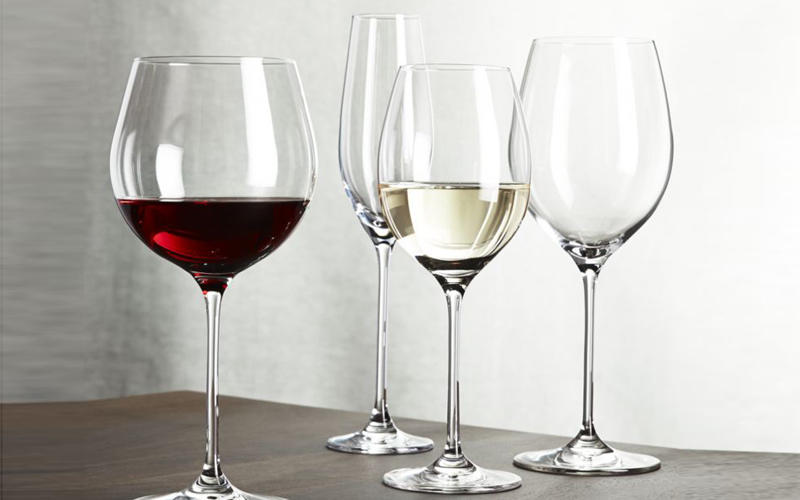That awkward moment when the server brings an extra-tall wine glass for you, a tulip-shaped one for your dining partner, and narrow ones to the next table. It makes you wonder if you’ve been doing it wrong all along.
Why do wine glasses come in so many styles? How do you know which kind to use? Does it really make a difference?
“The world of wine glasses can seem intimidating,” acknowledges Gabe Geller, a top sommelier and Director of Public Relations for Royal Wine. “The varieties are endless. The truth is, it can be as simple or as complex as you want it to be.”
Royal Wine, a leading producer, importer and exporter of wines and spirits, wants to demystify the wine glass so people can spend more time enjoying their wine – and less time worrying about the vessel.
Red, white, rosé, sparkling, or dessert wine?
It’s all about physics, says Geller. “The bowl of the glass is designed with surface area in mind. Red wines generally need to breathe, so a fuller, rounder bowl with a wide opening suits them best. Whites stay cooler in bowls that are straighter on the sides.”
Rosés can be served in white wine glasses because the two are produced similarly. But, says Geller, there are glasses made specifically for rosés. They have shorter bowls that are slightly tapered and sometimes have a flared rim. “The rim affects the way you sip,” he explains. “The flair helps direct the wine directly to the tip of the tongue.”
Tall, narrow glasses, sometimes called flutes, capture the carbon dioxide in sparkling wines, keeping the bubbly bubblier. The smallest of them all is the dessert/fortified wine glass, designed to send the sweet sip directly to the back of the mouth.
Differences within the differences
Serious oenophiles may insist on subtle variations within the basic categories above. A pinot noir, for example, would be served in a balloon-shaped glass, while its more rarified red cousin, the grand cru, is best featured when sipped over a flared rim. A wider mouth helps release the bold, acidic qualities of full-bodied whites like Herzog Lineage Chardonnay, whereas a smaller mouth holds the delicate aromas of light whites like Teal Lake Sauvignon Blanc.
Glass or crystal?
In theory, crystal is preferable to glass. Geller says the biggest advantage to crystal is its mineral content, which makes it durable enough to produce very thin stemware. This allows for a smoother flow into the mouth, not to mention a clearer view of the wine’s color and viscosity.
But does it affect the taste? Some insist it does. According to the website Wine Tasting Reviews, “The best explanation offered so far is that crystal is rougher than regular glass and this roughness creates turbulence in the wine which, in turn, causes more of the aromatic compounds in the wine to be released.”
But for most people, the main difference between crystal and glass is cost. Geller assures us it’s perfectly acceptable to serve wine in a regular glass made of glass – preferably one that’s clear, un-etched, and uncut to better see what’s inside. Again, it’s easier to enjoy your wine when you’re not worried about breaking your valuable crystal.
If you had to choose just one type of glass…
Many in the industry share a healthy skepticism when it comes to amassing a collection of “perfect” glasses for every type of wine on the market. Some even suspect it’s all a marketing ploy by upscale stemware manufacturers.
Geller agrees. “There’s no reason to think you’ll ever be judged by your stemware,” he says, “and you don’t have to be a professional sommelier to choose the right glass.”
In fact, you can get by with one set (or two if you like to serve bubbly). Geller recommends a thin glass with a large bowl that narrows at the top, ideally holding about 13 oz. of wine. “A good universal wine glass is perfectly suitable for anything, from your summer afternoon Ramon Cardova Rosado to a vintage Bordeaux such as Baron de Rothchild Haut-Medoc,” he says.
Royal Wine offers libations to fill every type of wine glass, with wines and spirits from the best wine producing regions of the world, available in almost every price range. Today their Bartenura Moscato in its iconic blue bottle is a top seller among all Moscatos.
***
Founded in 1848, Royal Wine Corp. has been owned and operated in the United States by the Herzog family, whose winemaking roots go back eight generations to its origin in Czechoslovakia. Today, Royal Wine’s portfolio of domestic and international wines range from traditional wine producing regions of France, Italy and Spain, as well as Israel, New Zealand and Argentina. Additionally, Royal Wine Corp.’s spirit and liqueur portfolio offer some of the most sought-after scotches, bourbons, tequilas and vodkas as well as hard to find specialty items such as flavored brandies and liqueurs. The company owns and operates the Kedem Winery in upstate New York, as well as Herzog Wine Cellars in Oxnard, California, a state-of-the-art-facility featuring guided wine tours, a fully staffed modern tasting room, gift shop and catering facilities. Additionally, the winery houses the award-winning restaurant Tierra Sur, serving the finest, Mediterranean-inspired, contemporary Californian Cuisine.

